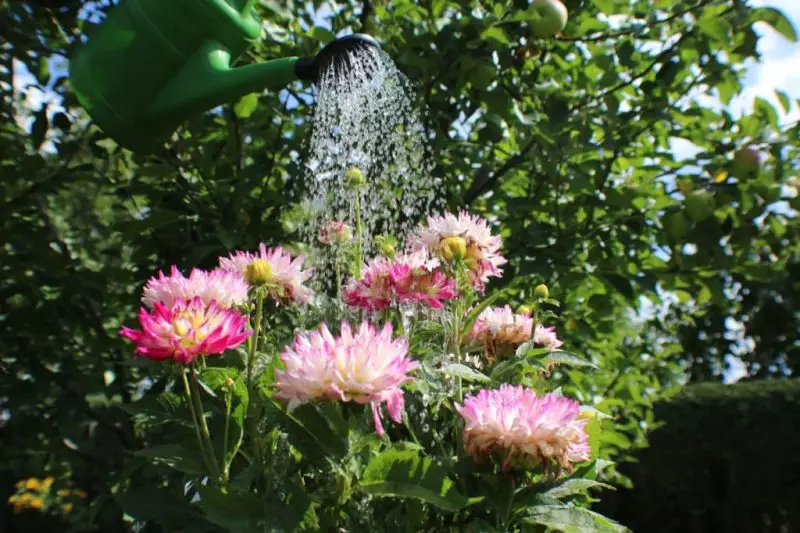Dahlias are among the most striking flowers a gardener can grow. Their bold shapes and dazzling colors fill gardens with life from midsummer until frost. But to achieve such beauty, dahlias need one essential ingredient—consistent and proper watering. Too much water leads to rot, while too little leaves the plant weak and wilted. Understanding how often to water dahlias determines whether they thrive or struggle. Many gardeners underestimate how sensitive dahlias are to soil moisture. Their roots demand careful balance, where every drop matters. Perfect watering creates firm stems, rich foliage, and vibrant blooms that seem to glow under the sun.
This guide reveals the art and science behind watering dahlias correctly. You’ll learn how soil, weather, and growth stage affect their hydration needs. Whether you grow them in the ground or pots, timing and technique make all the difference. We’ll explore how to recognize thirst, prevent rot, and build strong, resilient roots. Dahlias respond clearly to the right care, rewarding you with an explosion of color and form. Once you master their rhythm, your garden becomes a living gallery of blooms that never fade before their time.
Understanding Dahlia Water Needs

Dahlias are sensitive plants that depend on steady moisture to grow strong and healthy. Their roots form a network of tubers that store both water and nutrients. These tubers allow the plant to survive dry periods, but they can rot easily when water stands too long. Understanding how dahlias absorb and use water helps you create a consistent routine. Water moves upward from the roots through hollow stems to nourish leaves and flowers. If moisture drops suddenly, blooms fade, and stems weaken. Too much water suffocates roots, cutting off air and leading to decay. Balanced watering keeps energy flowing evenly from the soil to the petals.
Soil type plays a major role in how dahlias handle moisture. Sandy soil drains too quickly, often requiring more frequent watering. Clay soil, however, holds water longer and must dry slightly between sessions. Loamy soil provides the perfect middle ground. It drains well yet retains enough water for deep root growth. Always check the soil about two inches below the surface before watering again. If it feels cool and slightly damp, the dahlias are satisfied. Dry or dusty soil signals that it’s time to water thoroughly.
Weather patterns also influence your watering schedule. Dahlias drink more during hot, windy, or sunny days and less in cool, cloudy weather. Rainfall counts toward their weekly moisture needs, so adjust accordingly. During rapid growth and blooming, their thirst peaks. A clear understanding of these patterns ensures lush foliage and continuous, vivid blooms all season long.
How Often to Water Dahlias by Growth Stage
Watering dahlias correctly requires understanding their growth cycle from planting to flowering. During the early stage, before shoots appear, water only enough to keep the soil slightly damp. Tubers need oxygen to sprout strong roots. Excess water causes rot before the plant even grows. In this stage, light watering every three to four days works best, especially in dry weather. Once green shoots appear above the surface, increase watering frequency slowly. Young dahlias need steady moisture, but the soil should still drain freely. Proper balance encourages the roots to anchor deeply and form a solid foundation.
When dahlias reach the mid-growth phase, their roots expand widely underground. At this time, deep watering becomes crucial. Water two or three times weekly, letting the soil absorb moisture to a depth of six to eight inches. Deep watering trains roots to grow downward, protecting the plant from heat stress. Avoid frequent shallow watering because it keeps roots near the surface, where heat dries them quickly. A consistent deep routine builds strong, stable plants that resist drought and produce more buds. Healthy roots always lead to stronger flowers.
During the blooming stage, dahlias become thirstiest. Their large blossoms draw water rapidly, especially under intense sunlight. Check the top few inches of soil daily. If it feels dry, water thoroughly until moisture reaches deep roots. Maintain even moisture without overdoing it. Proper watering during bloom preserves petal color and extends the flowering period beautifully.
Watering Dahlias in Different Soil Types
Watering Dahlias in Sandy Soil
Sandy soil drains fast, which makes watering dahlias more demanding. The loose texture doesn’t hold moisture for long, leaving roots dry quickly. In warm climates, watering may be needed daily or every other day. The goal is to keep the soil evenly moist without flooding it. Shallow watering doesn’t help, as water evaporates too quickly. Instead, soak deeply so moisture reaches the lower roots where nutrients are absorbed best. Mixing compost, coconut coir, or well-rotted manure helps sandy soil retain water longer.
During hot or windy days, sandy soil dries out almost instantly. Mulching with bark, straw, or leaves helps reduce evaporation and regulate temperature. Early morning watering allows time for deep absorption before the sun heats the ground. Avoid watering at night because damp surfaces can attract slugs or promote fungal growth. Over time, improving sandy soil with organic matter builds a healthy ecosystem where dahlias grow stronger and bloom brighter. Consistent care turns even dry, loose soil into a supportive home for vibrant flowers.
Watering Dahlias in Clay Soil
Clay soil holds water longer but often drains poorly, making watering tricky. Overwatering quickly suffocates the roots and causes rot. To succeed, water deeply but less frequently, letting the top few inches dry before the next session. Check the soil by hand; if it feels sticky or heavy, wait before watering again. Dahlia roots need both air and moisture to stay strong. Shallow, frequent watering weakens them and creates standing water. Allowing short dry intervals encourages deep root systems that handle weather changes better.
Improving clay soil helps prevent most watering problems. Add coarse sand, compost, or perlite to improve aeration and structure. These materials break up dense particles, giving water room to move and oxygen to flow. Drip systems or soaker hoses are excellent tools because they release water slowly and evenly. Mulching further stabilizes moisture levels and prevents soil from baking hard in the sun. Balanced watering in clay soil ensures firm stems, healthy roots, and a longer, brighter blooming season.
Watering Dahlias in Loamy Soil
Loamy soil offers the ideal balance for growing dahlias. It holds moisture long enough for roots to absorb nutrients yet drains well enough to avoid soggy conditions. Water two or three times a week, adjusting for rainfall and temperature. Always check moisture two inches below the surface; if it feels dry, water deeply until the soil darkens evenly. Loamy soil absorbs water efficiently, so steady soaking works better than quick sprinkling. Consistent hydration supports strong tuber development and lush foliage growth.
Mulching enhances loam’s natural properties by regulating moisture and temperature. Organic mulch such as straw or shredded bark slows evaporation and prevents surface crusting. Loamy soil also benefits from regular compost additions, which boost nutrient levels and maintain softness. During the flowering stage, loam retains enough moisture to keep blooms full and vibrant. Watering early in the morning or late afternoon reduces stress and conserves moisture. With this care, dahlias in loamy soil deliver steady growth, brilliant color, and dependable beauty all season long.
Watering Dahlias in Different Weather Conditions
Watering Dahlias During Hot Weather
Hot weather pushes dahlias to their limits. Intense sunlight and warm air dry soil rapidly, sometimes within a few hours. In this heat, dahlias often require watering once every day, especially in sandy or exposed areas. Water deeply each time to reach the lower root zone. Shallow watering evaporates quickly and leaves the roots dry. Early morning watering works best because it allows moisture to soak in before heat builds. Avoid watering late at night, as standing moisture invites fungal diseases. Consistency is vital during heatwaves.
Mulching is a gardener’s secret weapon in hot weather. A two-inch layer of straw, bark, or leaf mulch keeps soil cooler and reduces evaporation. Shade cloths or nearby tall plants can shield dahlias from harsh afternoon sun. Check for early signs of stress such as curling or drooping leaves. Increase watering frequency when dry winds blow or temperatures stay above 90°F. Proper hydration helps dahlias maintain steady growth, bright petals, and sturdy stems even during scorching conditions. Healthy, well-watered plants endure the summer heat gracefully.
Watering Dahlias During Rainy Seasons
Excess rain can overwhelm dahlias quickly, especially in poorly drained soil. Constant wetness leads to root rot and fungal problems. During long rainy periods, hold off on watering until the ground dries slightly. Stick your fingers a few inches deep—if it feels heavy or sticky, wait before watering again. Raised beds or mounded soil improve drainage and protect roots from standing water. Airflow around the base is also important, as it helps leaves dry faster after rain.
After heavy rain, check the soil condition closely. Remove soggy mulch or plant debris that traps moisture. If the rain continues, gently loosen compacted soil around the roots to let air in. Add compost or perlite to improve long-term drainage and prevent puddles. When the sky clears, resume watering slowly to avoid shocking the roots. Dahlias thrive best when soil moisture remains balanced, never soggy. Managing wet conditions carefully ensures strong root recovery, prevents disease, and keeps your plants blooming even after extended rainfall.
Watering Dahlias During Cold or Windy Weather
Cold or windy weather changes how dahlias handle water. In cool temperatures, the plant slows growth and absorbs less moisture. Overwatering during this time easily causes soggy soil and root decay. Reduce frequency but never let the soil go completely dry. Check the top inch every few days, watering only when it feels dry. Light, infrequent watering maintains healthy hydration without overwhelming the roots. Dahlias prefer steady moisture, even during dormancy.
Windy weather creates a different challenge. Strong gusts dry soil and leaves faster than expected. Protect plants with mulch to keep moisture locked near the roots. If your garden faces constant wind, use low barriers or taller companion plants as windbreaks. Water early in the morning so moisture penetrates before evaporation starts. Always inspect soil after windy days and adjust watering if dryness spreads. By managing cold and wind with care, you ensure dahlias remain strong, flexible, and well-hydrated until warmth returns.
How to Check If Your Dahlias Need Water
Knowing when your dahlias actually need water is as important as knowing how often to water them. Many gardeners water on schedule without checking the plant first. The best way to know is by feeling the soil. Push your finger two inches deep into the ground near the base. If it feels dry or warm, it’s time to water. If it feels cool and slightly damp, the plant is fine. Surface dryness doesn’t always mean thirst, especially after hot days. Dahlias prefer deep, steady moisture rather than frequent, shallow watering. Checking before each session helps you avoid overwatering and root rot.
The leaves also reveal how much moisture the plant holds. Slight drooping in the afternoon heat is normal, but constant wilting signals dehydration. When leaves curl, turn yellow, or feel limp, the roots can’t access enough water. In contrast, if leaves look soft and pale with dark soil underneath, they may be overwatered. Dahlias communicate clearly once you learn to read their signs. Watching these cues daily builds your understanding of their rhythm and needs.
Soil type and weather also change how moisture behaves. In sandy soil, water drains fast and must be replenished more often. In heavy clay, water lingers longer, so check carefully before watering again. A soil moisture meter can help if you want accuracy. Observing, feeling, and responding—not guessing—will make watering far more effective. With attention and practice, you’ll always know exactly when your dahlias need that refreshing drink.
Common Watering Mistakes with Dahlias
Overwatering and Root Rot
Overwatering remains one of the most common and destructive mistakes in growing dahlias. Constantly wet soil blocks oxygen flow and suffocates the roots. The tubers begin to rot from the inside, and their tissues turn soft and brown. You may also notice a sour smell rising from the soil. Leaves start yellowing from the base upward, and new shoots slow or stop completely. This happens more often in clay soil or poorly drained pots. Dahlias prefer consistent moisture but never soggy conditions. Before watering, always test the soil. If the second inch feels damp, delay watering another day.
To reverse damage, aerate the soil gently and allow it to dry partially. Mixing compost, sand, or perlite improves drainage and airflow. Remove mulch for a few days to help moisture escape faster. If rot develops, dig up the tubers, cut away affected areas, and dust them with sulfur powder before replanting. Once recovery starts, water deeply but less often. Healthy soil structure and rhythm prevent overwatering and strengthen the plant’s natural resistance to fungal problems. Balanced watering always results in vigorous growth and prolonged flowering.
Underwatering and Dehydration
Underwatering causes dahlias to weaken slowly and lose vigor. When soil dries out too deeply, roots contract and struggle to absorb nutrients. The first visible symptom is limp, dull leaves that fail to recover overnight. Petals fade quickly, buds dry before opening, and stems become brittle. Shallow watering makes this worse because moisture never reaches the deep roots where dahlias store energy. During hot, windy weather, soil dries faster, demanding closer monitoring. Dahlias need deep, regular watering to sustain lush foliage and strong blooms throughout the season.
To fix dehydration, water thoroughly until moisture reaches at least eight inches deep. Do this early in the morning when temperatures are mild and evaporation is low. Add mulch or compost around the base to lock humidity and protect the soil from extreme heat. For potted dahlias, increase watering frequency but reduce the amount each time. Regular, steady hydration allows the plant to recover within days. Once soil moisture stabilizes, dahlias regain firmness, vibrant color, and bloom longevity. Proper watering habits ensure strength, balance, and continuous flowering.
Inconsistent Watering Schedule
Irregular watering creates unstable moisture conditions that confuse and weaken dahlias. When soil swings from dry to soaked repeatedly, roots experience stress and lose strength. They either rot from overexposure or shrivel during dry gaps. This imbalance shows through uneven growth, pale leaves, and inconsistent blooms. Dahlias need predictable moisture levels to maintain steady nutrient flow. Inconsistent care leads to shorter flowering cycles, weaker stems, and reduced petal quality. A well-timed watering rhythm helps the plant build balance and resilience.
To fix inconsistency, create a routine that fits your climate and soil. For garden dahlias, water deeply twice weekly in warm weather, adjusting for rainfall. In containers, water more often since pots dry faster. Avoid quick splashes and instead water until the soil feels moist eight inches deep. Apply mulch to stabilize temperature and reduce moisture loss. Observe your plants daily; consistent soil texture indicates proper hydration. Over time, a regular schedule helps roots grow deeper, flowers bloom stronger, and your dahlias maintain lush, radiant growth from summer to fall.
Seasonal Watering Guide for Dahlias
Spring Watering: Supporting Early Growth
Spring marks the awakening of dahlias after their winter rest. As tubers begin to sprout, their roots require steady but gentle moisture. Overwatering at this stage can delay growth and cause rot. Start by watering lightly once or twice weekly, depending on soil type and weather. The goal is to keep the soil evenly moist but never soggy. Always test two inches below the surface before watering again. If the soil feels cool, skip a day. Dahlias need oxygen just as much as water to start strong.
As shoots emerge, gradually increase watering depth to encourage roots to spread downward. Deep watering helps establish stability and prevents weak, shallow roots. Mulching the area around the base protects tender sprouts from temperature swings and retains moisture. In regions with spring rain, reduce watering to prevent over-saturation. Once the plants reach about a foot tall, switch to deeper, consistent watering to fuel leaf and stem development. Proper spring hydration ensures dahlias develop strong foundations for vigorous summer blooming.
Summer Watering: Fueling Flower Production
Summer is the most demanding season for watering dahlias. The plants grow fast, bloom heavily, and lose moisture quickly under the heat. Water deeply two to three times weekly, ensuring the soil stays moist eight inches down. Shallow watering leads to weak stems and smaller flowers. Early morning watering works best, reducing evaporation while giving roots time to absorb before the sun peaks. Dahlias in containers dry faster, so they may need watering daily during heatwaves.
Mulching with organic materials such as straw or compost helps maintain soil moisture and keeps the roots cool. Consistent deep watering promotes large, colorful blooms and prevents sudden wilting. Avoid wetting the foliage, as excess moisture on leaves invites disease. During extremely hot spells, shade your plants slightly and check soil moisture daily. A balanced watering rhythm in summer ensures strong roots, rich foliage, and continuous flower production until late in the season. Healthy hydration directly translates into brighter, longer-lasting blooms.
Fall Watering: Preparing for Dormancy
As autumn arrives, dahlias begin storing energy for the next growing cycle. Cooler air and shorter days slow their water use, so reduce watering gradually. Continue deep watering once a week until the flowers fade. This final hydration supports tuber growth beneath the soil. Avoid letting the ground dry completely, as dehydration weakens tubers. Consistent moisture during fall helps strengthen the roots before dormancy.
Once frost approaches, stop watering entirely. Overly wet soil combined with cold temperatures encourages rot and fungal problems. If you plan to dig up tubers for winter storage, allow the soil to dry slightly before lifting them. This makes cleaning and drying easier. In milder climates, where tubers remain in the ground, mulch heavily after the final watering to insulate against freezing. Proper fall watering closes the growing season smoothly, ensuring the dahlias rest well and return stronger with lush growth next spring.
Factors That Affect Dahlia Watering Frequency
Several factors influence how often dahlias need watering, and understanding them ensures healthier plants and better blooms. The first key factor is soil type. Sandy soil drains quickly and requires frequent watering, while clay holds moisture longer but risks suffocating roots if not managed carefully. Loamy soil offers balance and needs watering two or three times weekly in warm weather. Soil texture directly affects water retention and determines how deep roots must reach for consistent hydration. Testing the soil regularly helps you adapt to these conditions instead of following a fixed schedule.
The second factor is climate. Hot, dry regions require more frequent watering because high temperatures and wind accelerate evaporation. In contrast, cooler or humid climates allow longer gaps between watering. Rainfall also plays a major role. During wet periods, reduce or even skip watering to avoid waterlogging. Seasonal changes demand flexible watering habits. Always watch how your dahlias respond to temperature, sunlight, and humidity rather than relying on a calendar. Observing the weather keeps hydration levels consistent and protects the plant from stress.
The third important factor is plant maturity. Young dahlias with shallow roots dry faster, needing gentle but regular watering. Mature plants with strong, established roots prefer deep, infrequent watering that reaches the lower soil layers. As dahlias bloom, their water needs peak, then slowly decrease as the season ends. Understanding these natural shifts helps you synchronize watering with the plant’s rhythm. Adapting care to these changing factors ensures healthy growth, bright color, and long-lasting beauty in every bloom.
Tips for Efficient Dahlia Watering
Efficient watering means giving dahlias what they need without wasting water or causing stress. The best approach is always slow, deep watering that reaches the lower roots. Shallow watering only wets the surface, forcing roots to stay near the top where heat dries them quickly. Deep watering encourages roots to grow downward, building stability and drought resistance. Water early in the morning so the soil can absorb moisture before the sun rises high. This timing also prevents fungal diseases that appear when leaves stay wet overnight. Even small changes in routine can make a big difference in the plant’s overall health.
Using mulch around your dahlias greatly improves watering efficiency. A two-inch layer of straw, bark, or compost helps the soil retain moisture and stay cooler on hot days. Mulch also prevents weeds from stealing water and nutrients. In windy or dry regions, adding mulch can reduce watering frequency by nearly half. Always refresh the layer as it decomposes to keep protection consistent. For container-grown dahlias, ensure pots have drainage holes to prevent standing water, and use slightly more frequent but smaller waterings for steady moisture.
Observation remains the most powerful watering tool. Watch the leaves, stems, and soil texture daily. When plants look vibrant and soil feels slightly cool, watering is perfect. If leaves wilt or soil hardens, adjust quickly. A mindful gardener learns each plant’s rhythm over time. Consistent attention ensures dahlias get exactly what they need—no more, no less. Efficient watering saves effort, conserves water, and rewards you with stronger, longer-lasting blooms.
FAQs About Watering Dahlias
How often should I water dahlias in summer?
In summer, water dahlias deeply two or three times a week. Always check soil moisture before watering again. Hot, dry weather increases evaporation, so early morning watering works best. Keep the soil evenly moist, not soaked. Deep watering builds strong roots and prevents heat stress during hot months.
Can I overwater dahlias if it’s very hot?
Yes, even in hot weather, too much water causes root rot. Dahlias need moisture, not saturation. Always test the soil before watering. If it feels cool and slightly damp, wait another day. Focus on deep, slow watering instead of frequent light watering to keep roots healthy.
Should I water dahlias after it rains?
No, wait until the soil starts drying before watering again. Rain often provides enough moisture for several days. Check two inches below the surface to be sure. If the soil still feels damp, skip watering. Overlapping rain and watering creates soggy conditions that harm the roots.
Do potted dahlias need more frequent watering?
Yes, pots dry faster than garden soil, especially under full sun. Water potted dahlias once daily during heatwaves and every other day in mild weather. Ensure proper drainage holes to prevent rot. Container soil should stay evenly moist, allowing oxygen to reach the tubers easily.
Is morning or evening better for watering dahlias?
Morning watering is best for dahlias. It allows roots to absorb water before heat increases evaporation. Wet leaves overnight invite disease, so avoid evening watering. Early hydration strengthens roots and prepares the plant for the day’s sunlight. Consistent morning watering keeps blooms bright.
Conclusion
Watering dahlias is an art that blends timing, observation, and patience. Each drop you give builds stronger roots and brighter blooms. Understanding soil, weather, and growth stages helps you create the perfect watering rhythm. Deep, consistent hydration keeps your dahlias thriving through every season. When you master this balance, your garden rewards you with endless color and elegance. Healthy watering habits not only save effort but also ensure lasting beauty year after year. Dahlias flourish best under careful hands, and the right watering routine turns good plants into spectacular displays of life.






